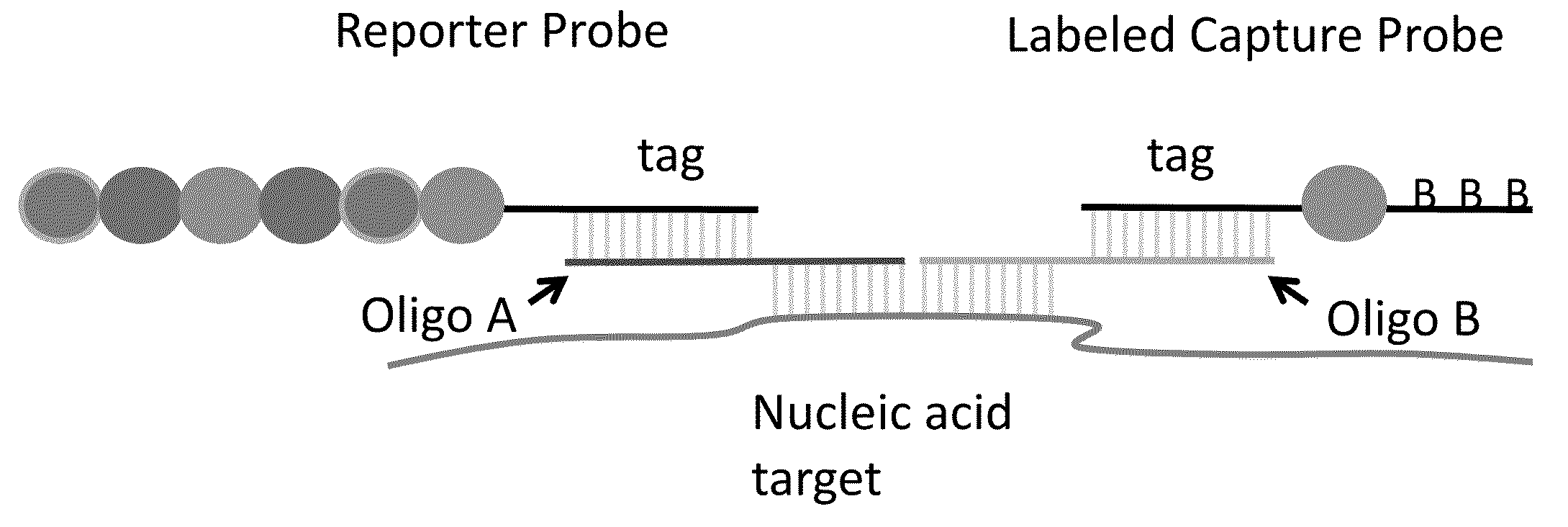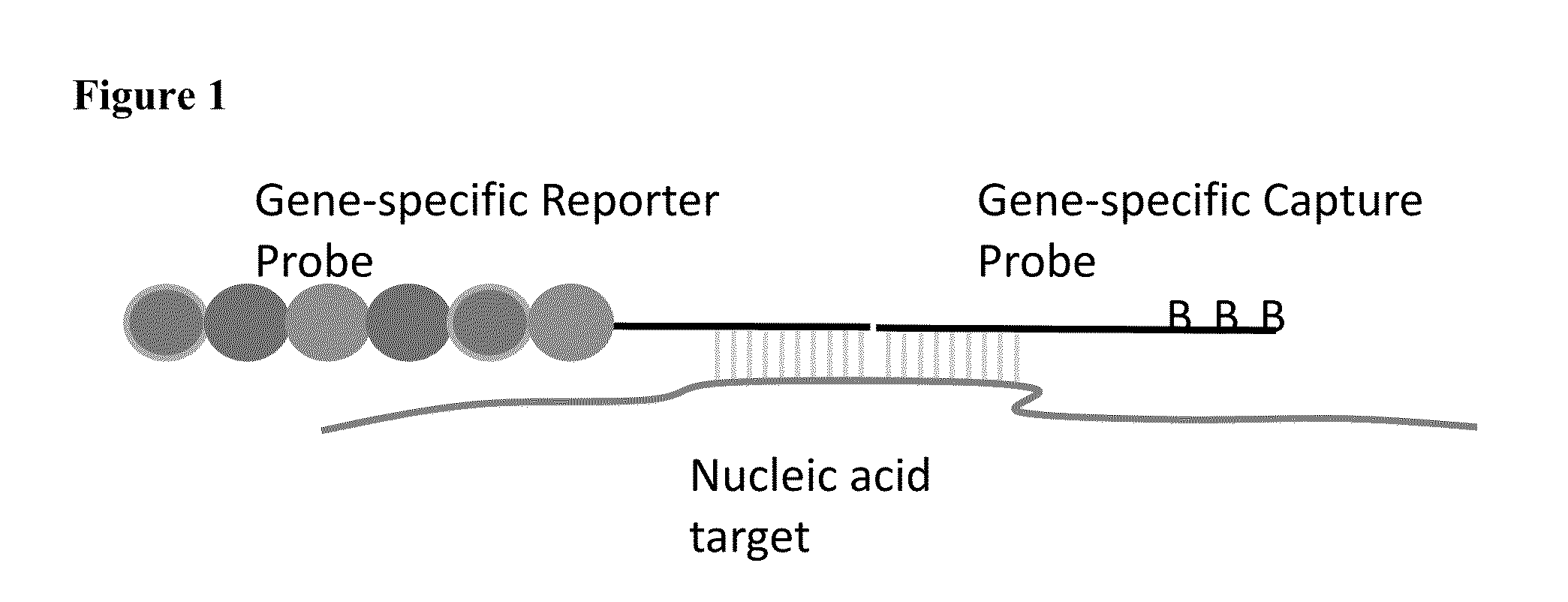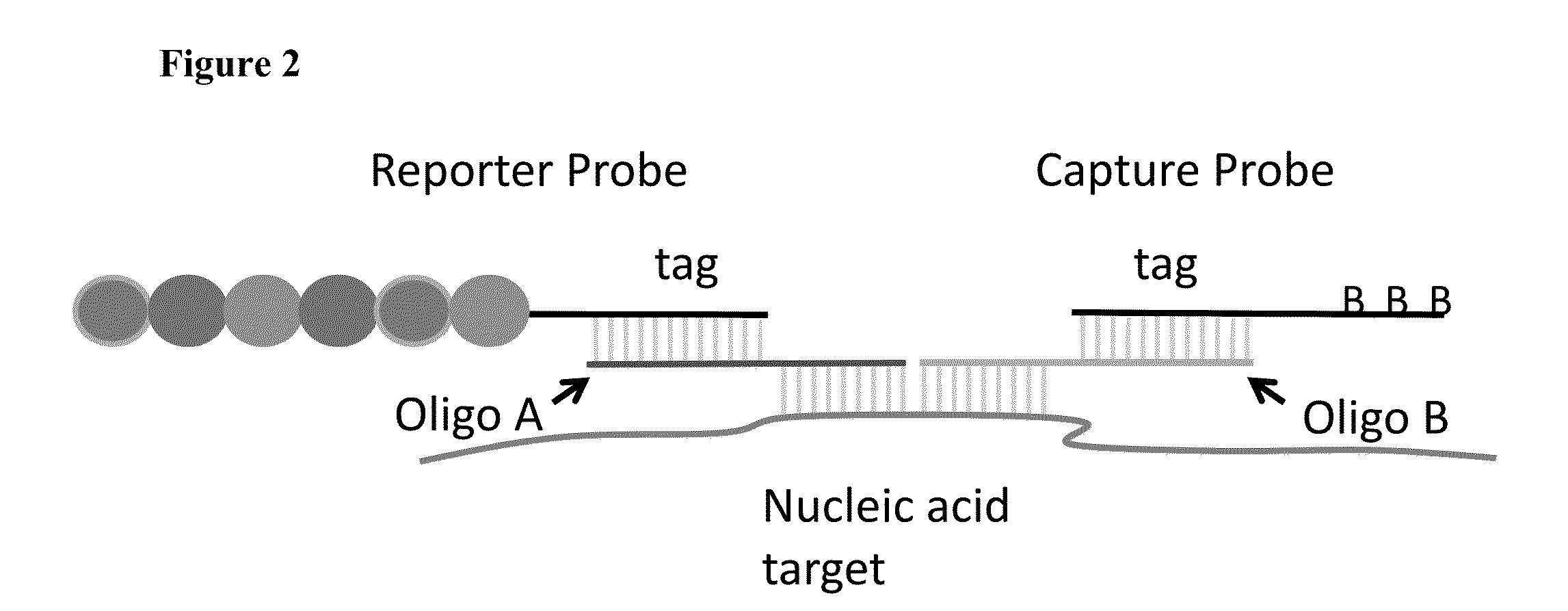Multiplexable tag-based reporter system
a reporter system and tag technology, applied in the field of multi-tag reporter system, can solve the problems of insufficient amount of biological samples required for microarray methods, many drawbacks still exist in molecular hybridization and microarray techniques, and the kinetics of hybridization on the surface of microarrays are less efficient than hybridization, so as to improve efficiency and consistency, increase flexibility in the content of assays, and reduce errors in code-target association
- Summary
- Abstract
- Description
- Claims
- Application Information
AI Technical Summary
Benefits of technology
Problems solved by technology
Method used
Image
Examples
example 1
Development of 35-Base Tag Sequences
[0273]35-base tag sequences for the reporter probes and reporter oligos were developed from “alien” sequence created by the External RNA Control Consortium (ERCC) at The National Institute of Standards and Technology. Starting with ERCC sequence, stretches of 35 bases were selected based on the following criteria:[0274]A. Tm of 78-82° C.[0275]B. No more than 3 G's or 3 C's in a row[0276]C. No more than 7 bases of homology in an inverted repeat[0277]D. No more than 9 bases of homology in a direct repeat[0278]E. G / C content of 30-70%[0279]F. BLAST alignments against non-redundant NCBI nucleic acid sequence database and all nanoreporter system components with an 11 nucleotide stringency cut-off for alignment and an overall identity or complementarity of no greater than 85% (to minimize cross-hybridization issues)[0280]G. the absence of EcoRI, PstI and HindIII restriction endonuclease recognition sites
[0281]For cloning purposes the selected sequences ...
example 2
Development of 25-Base Tag Sequences
[0282]25-base tag sequences for capture probes and capture oligos were developed in a similar manner to the 35-base tag sequences developed in Example 1, with the exception that the G / C content was increased to allow 80%, the final base was not changed to a G, and the tags were not screened for restriction sites. Instead of being cloned, the capture probe / capture oligo tags are synthesized directly as part of the capture probe molecule or capture oligo.
[0283]The tags were cloned into existing nanoreporter backbone plasmids using standard restriction endonuclease and ligation-based cloning techniques. Each tag was assigned to a unique backbone plasmid which is used to generate a unique barcode, so that there is a 1:1 correspondence between each barcode and its associated tag. In the tag-based system conventional nanoreporter synthesis protocols are used to generate a single-stranded DNA backbone which contains both the standard label attachment reg...
example 3
Comparison of Negative Control Between Standard and Tag-Based Nanoreporter Systems
[0284]In this example, the counts generated for an internal negative control were compared between the standard non-tag-based and tag-based nanoreporter systems. In the standard non-tag-based assay, a pool of 100 target-specific reporter probes was mixed with the appropriate target-specific capture probes. In the tag-based assay, a pool of 96 reporters with tag-based probes (e.g., reporter probe and reporter oligo) was mixed with the single universal capture probe necessary for the tag-based assay.
[0285]Mixes were incubated on ice for 30 minutes or for 2 hours. The pre-incubated mixes were subsequently used in hybridization reactions with the required additional assay components. The results in FIG. 4 show that the background signal generated during the assay set-up is significantly lower in the tag-based assay than the standard assay, and that it remains stable over time in the tag-based assay, while ...
PUM
| Property | Measurement | Unit |
|---|---|---|
| composition | aaaaa | aaaaa |
| affinity | aaaaa | aaaaa |
| nucleic acid | aaaaa | aaaaa |
Abstract
Description
Claims
Application Information
 Login to View More
Login to View More - R&D
- Intellectual Property
- Life Sciences
- Materials
- Tech Scout
- Unparalleled Data Quality
- Higher Quality Content
- 60% Fewer Hallucinations
Browse by: Latest US Patents, China's latest patents, Technical Efficacy Thesaurus, Application Domain, Technology Topic, Popular Technical Reports.
© 2025 PatSnap. All rights reserved.Legal|Privacy policy|Modern Slavery Act Transparency Statement|Sitemap|About US| Contact US: help@patsnap.com



